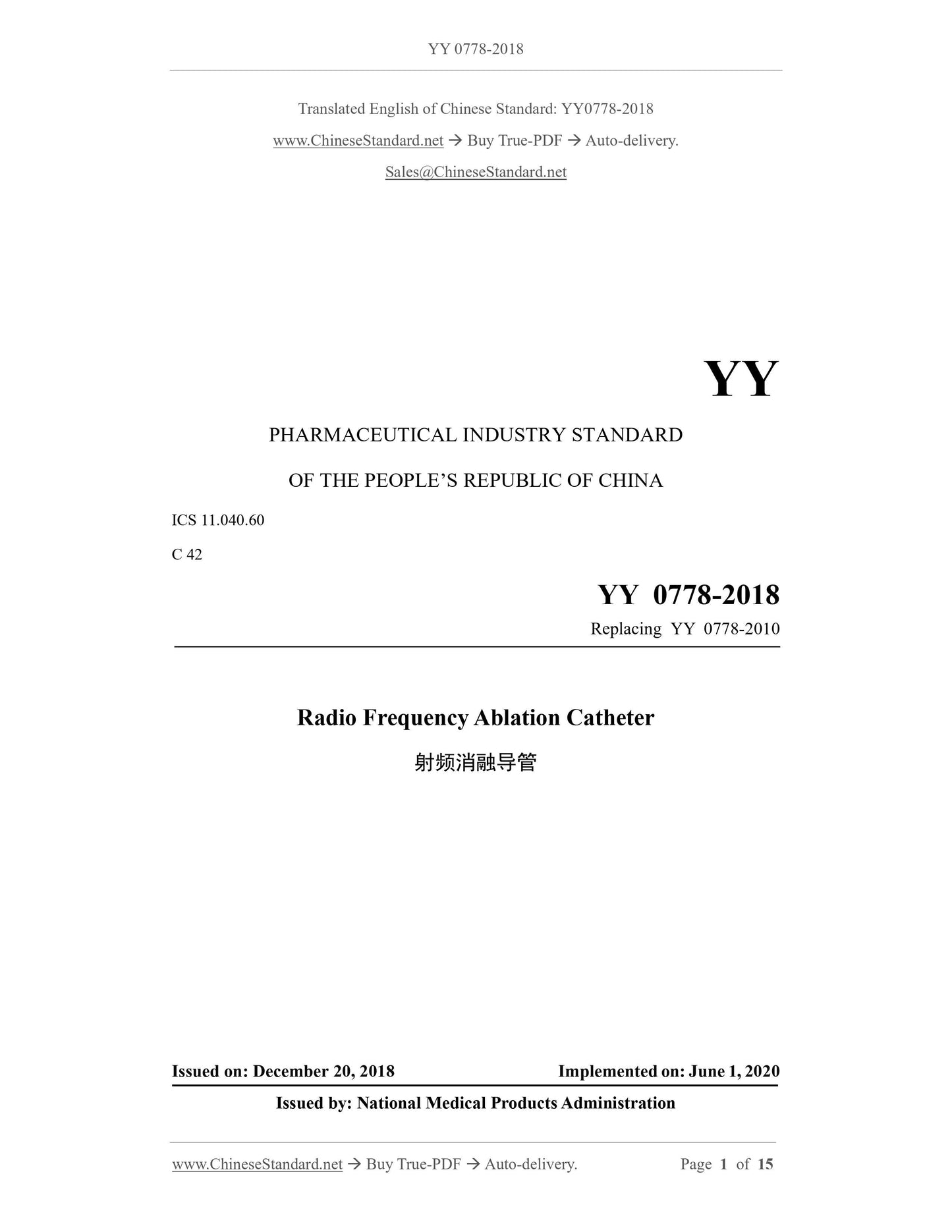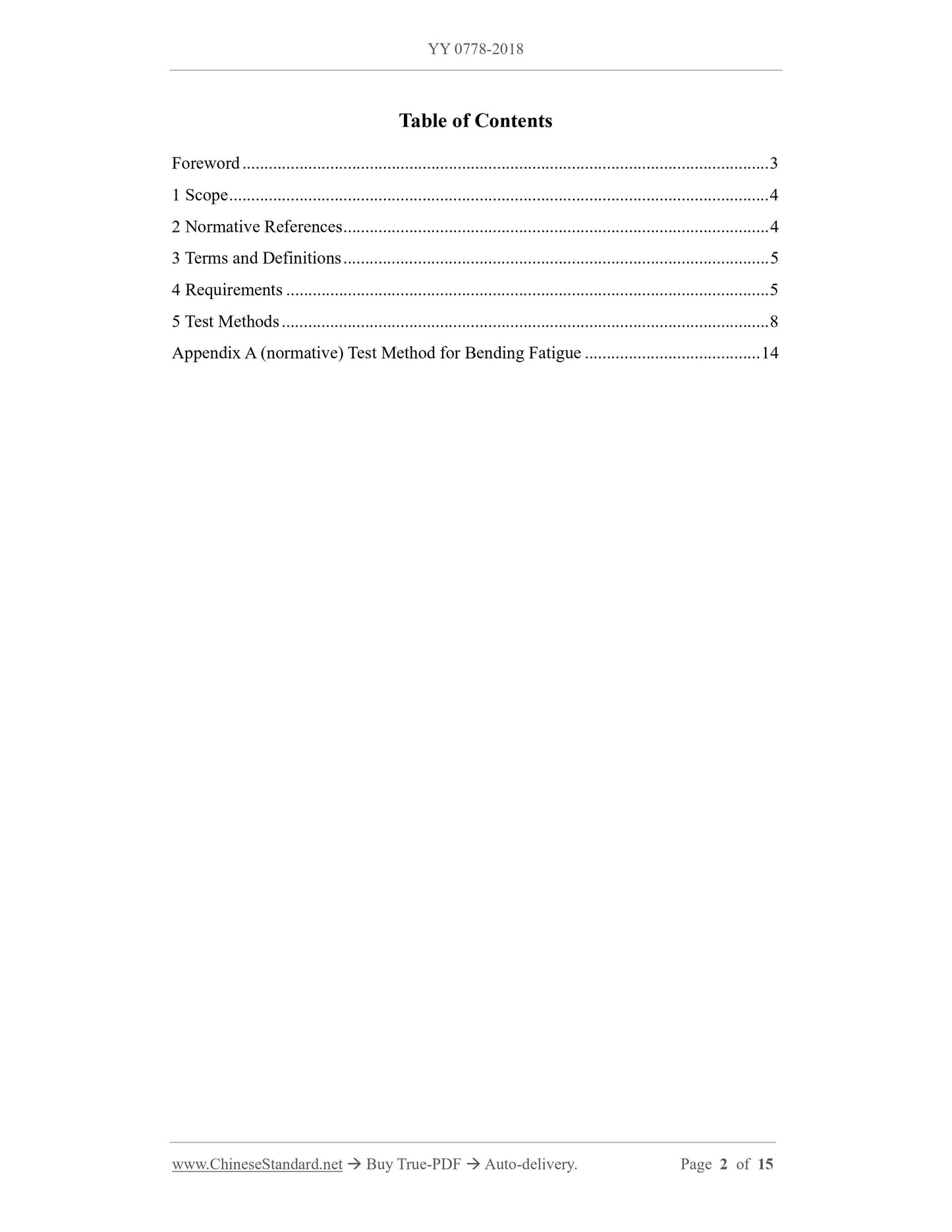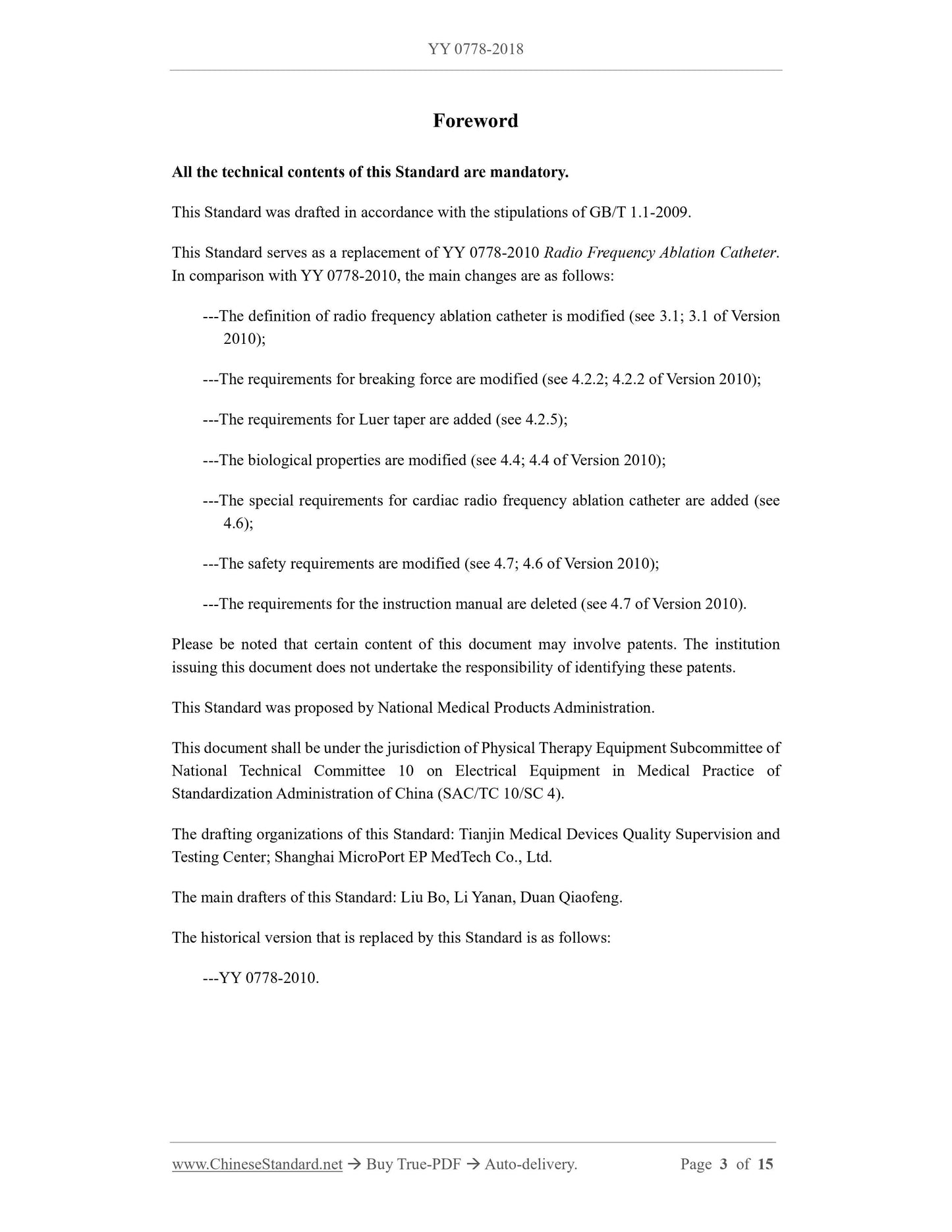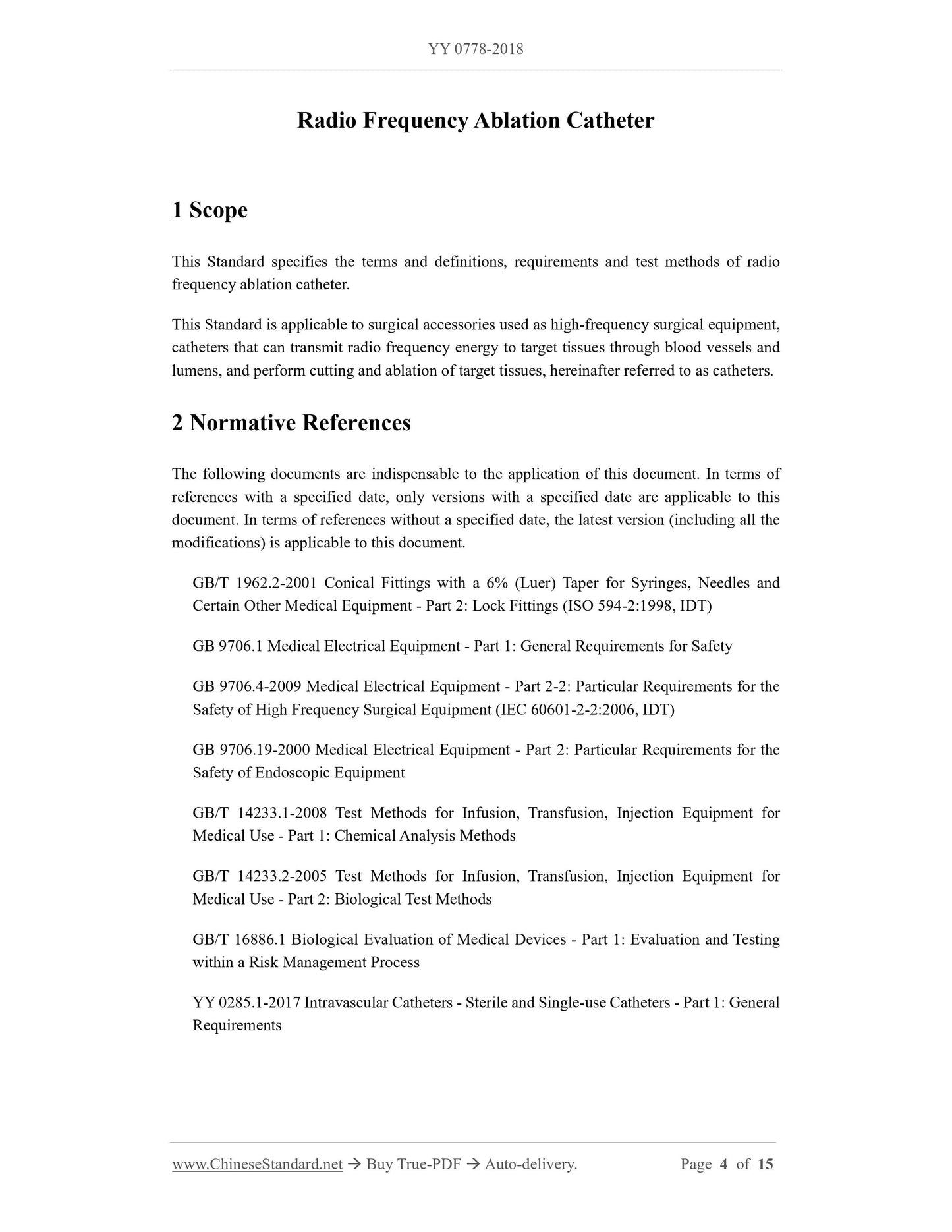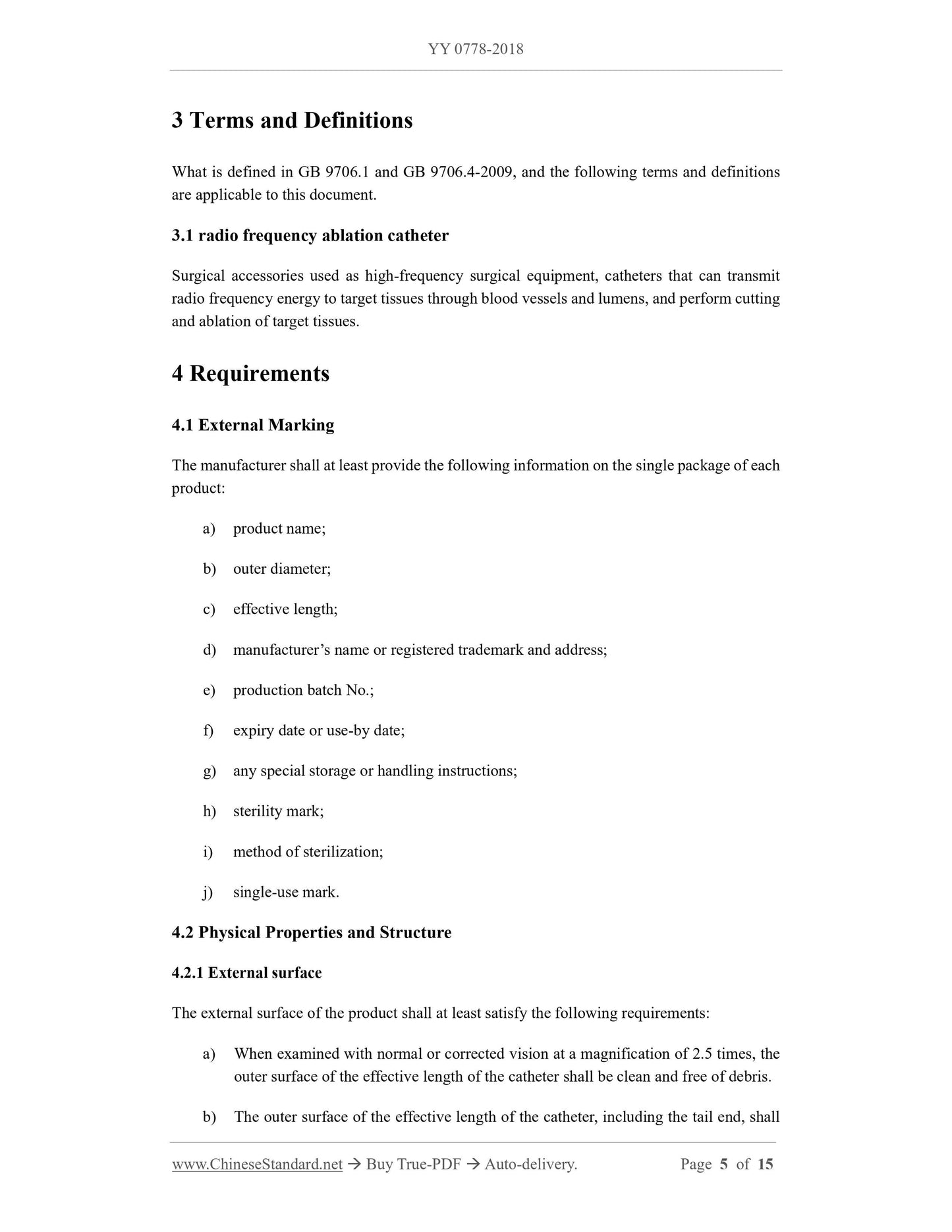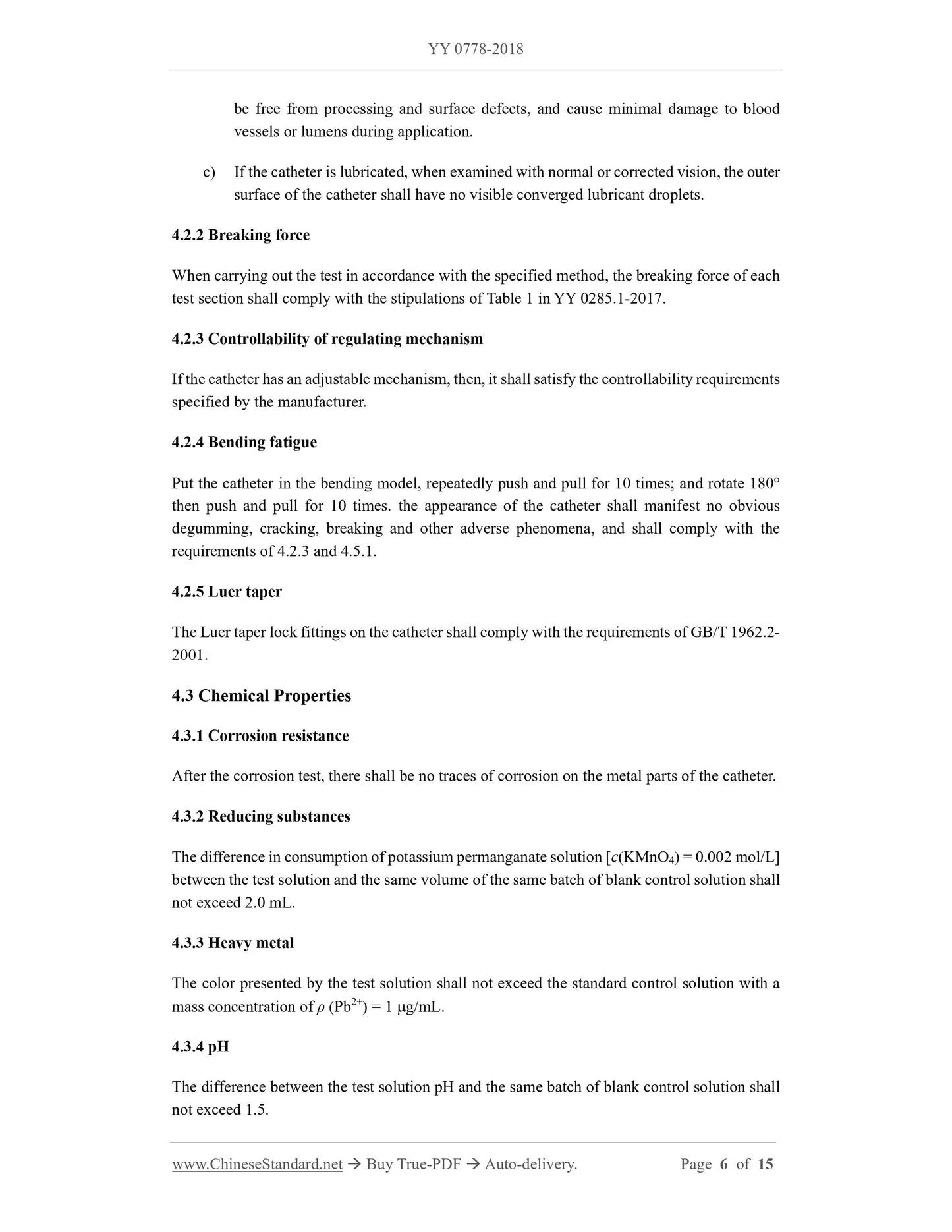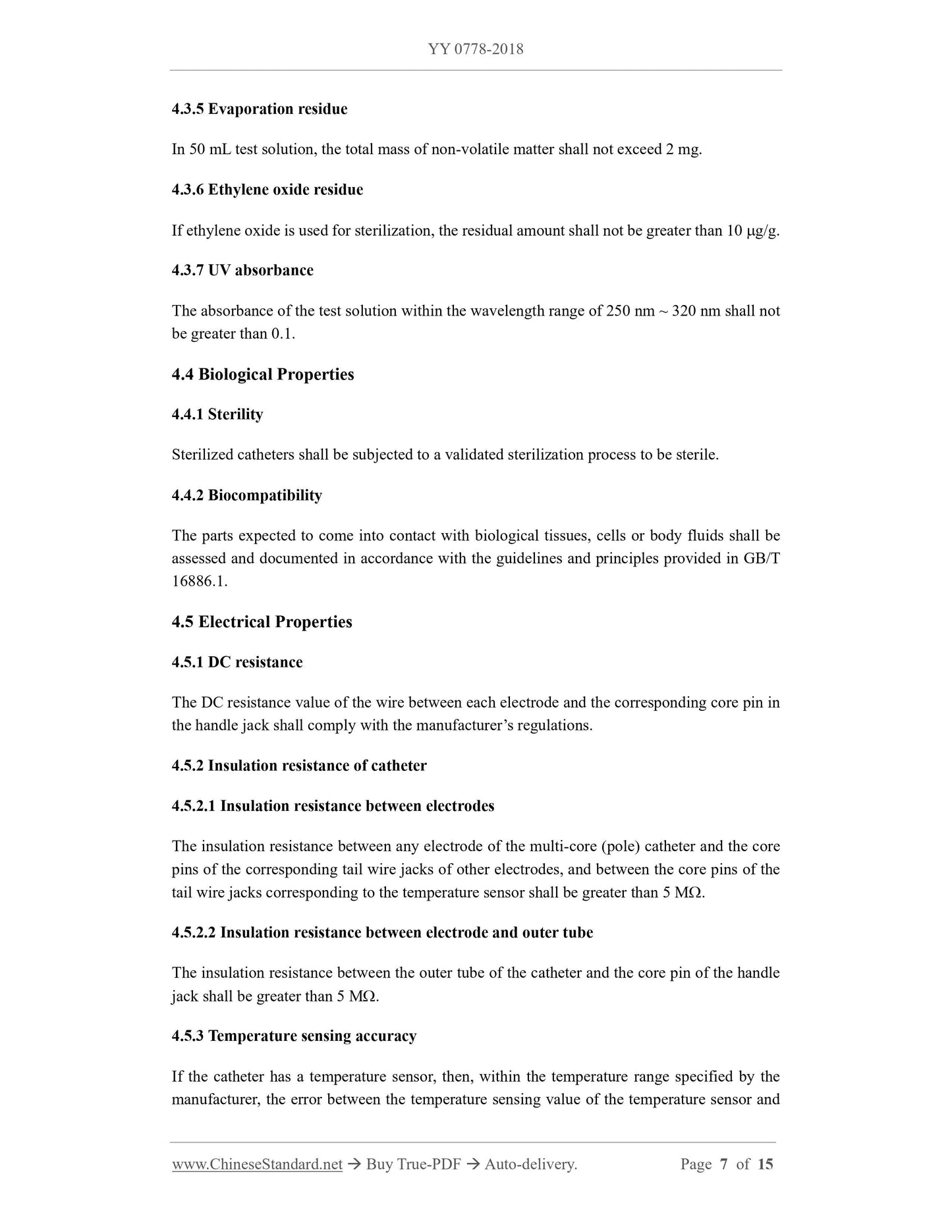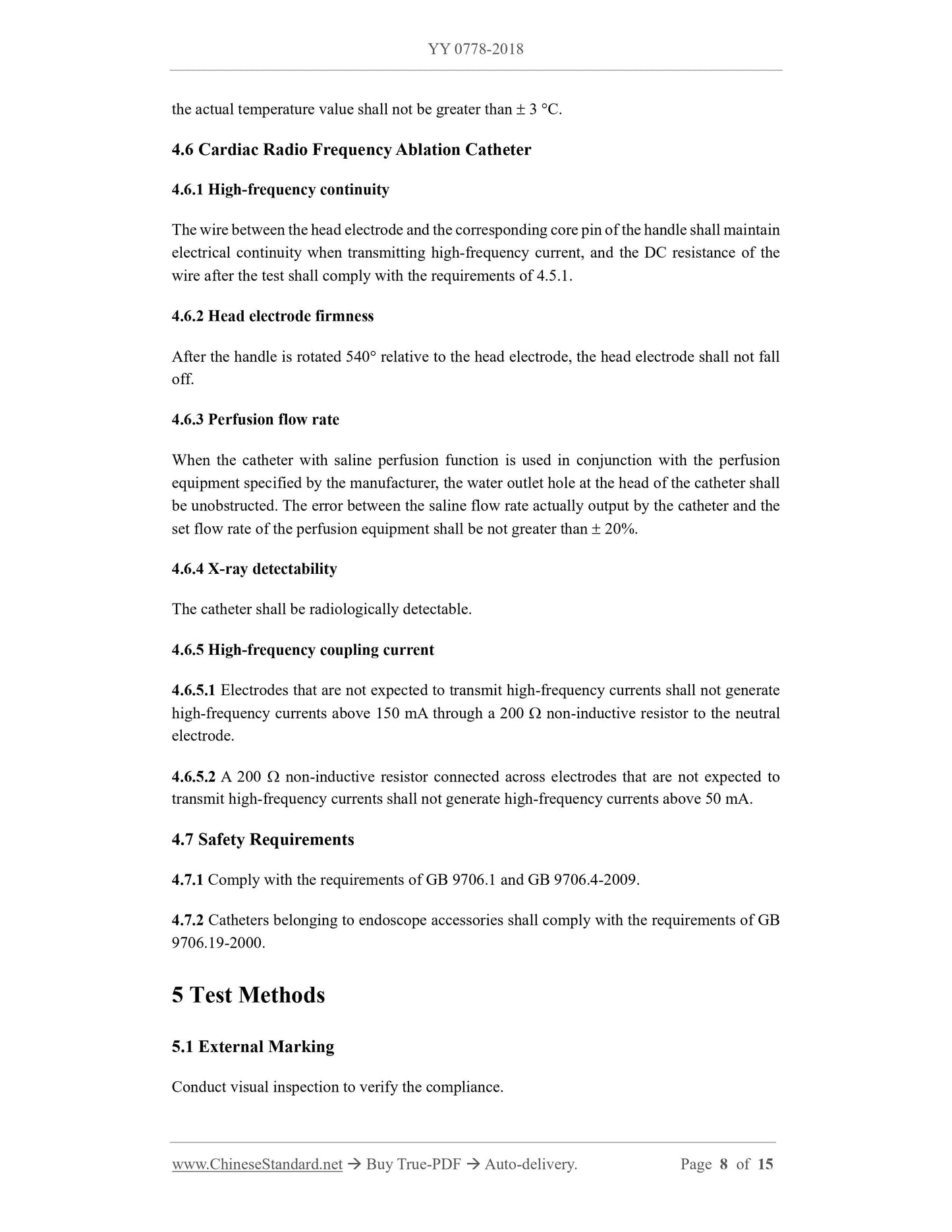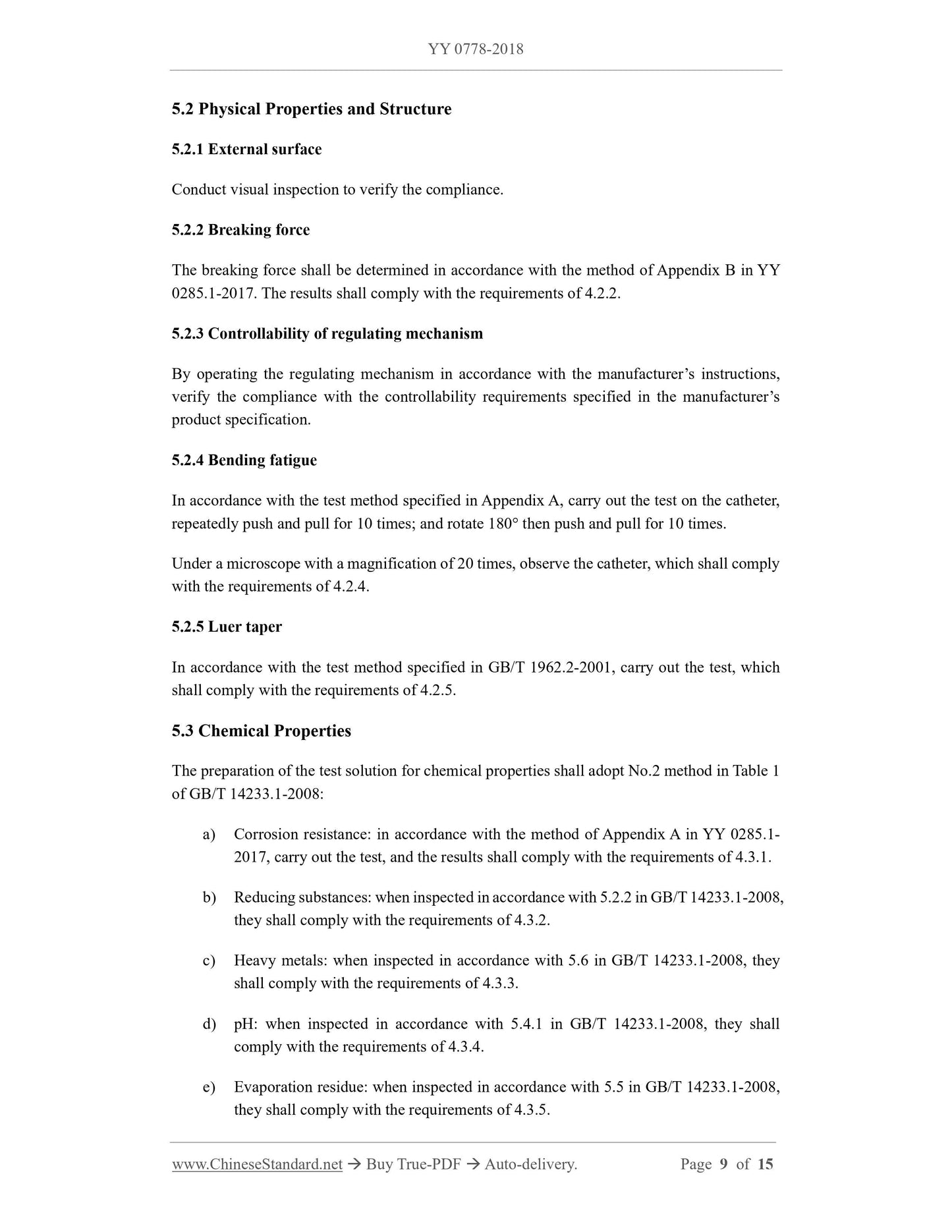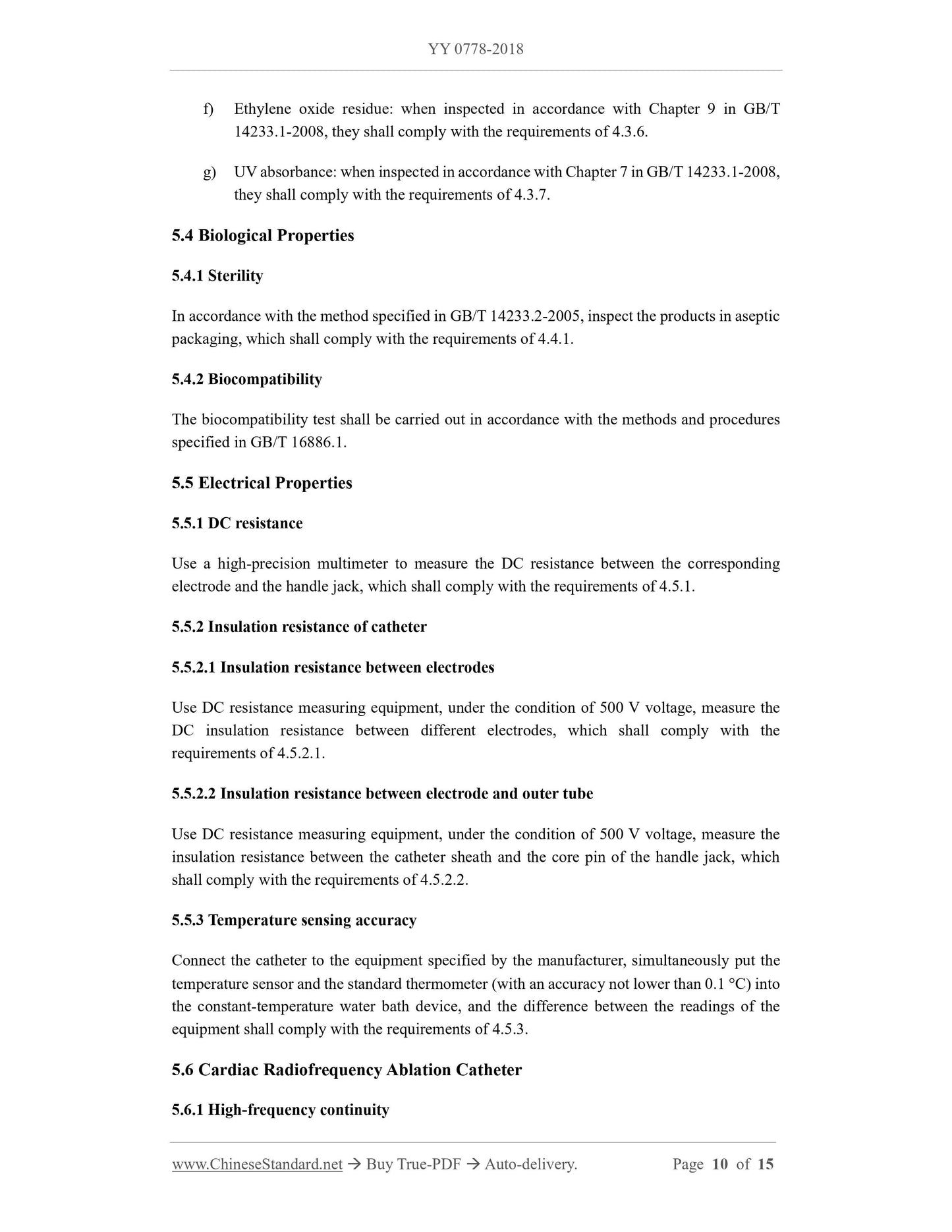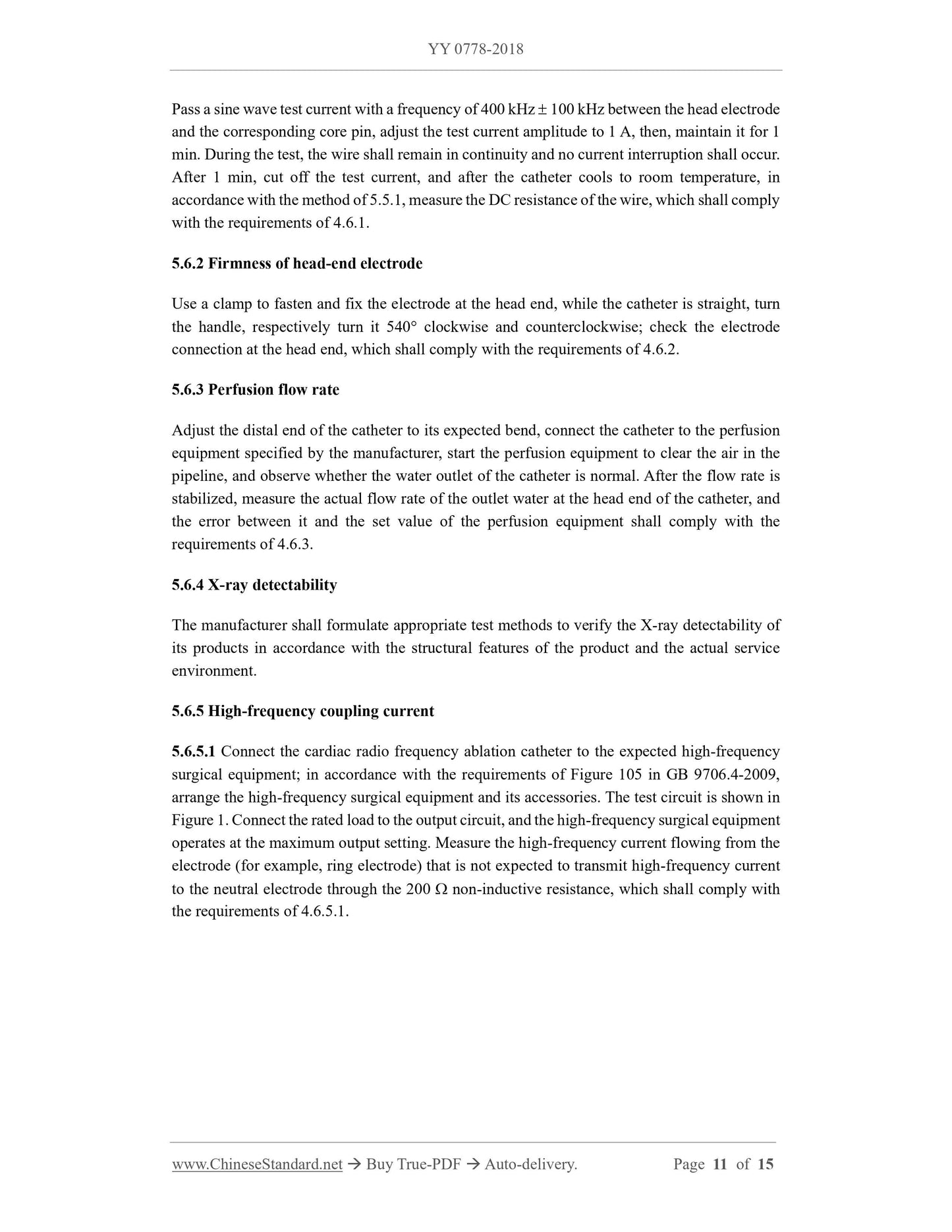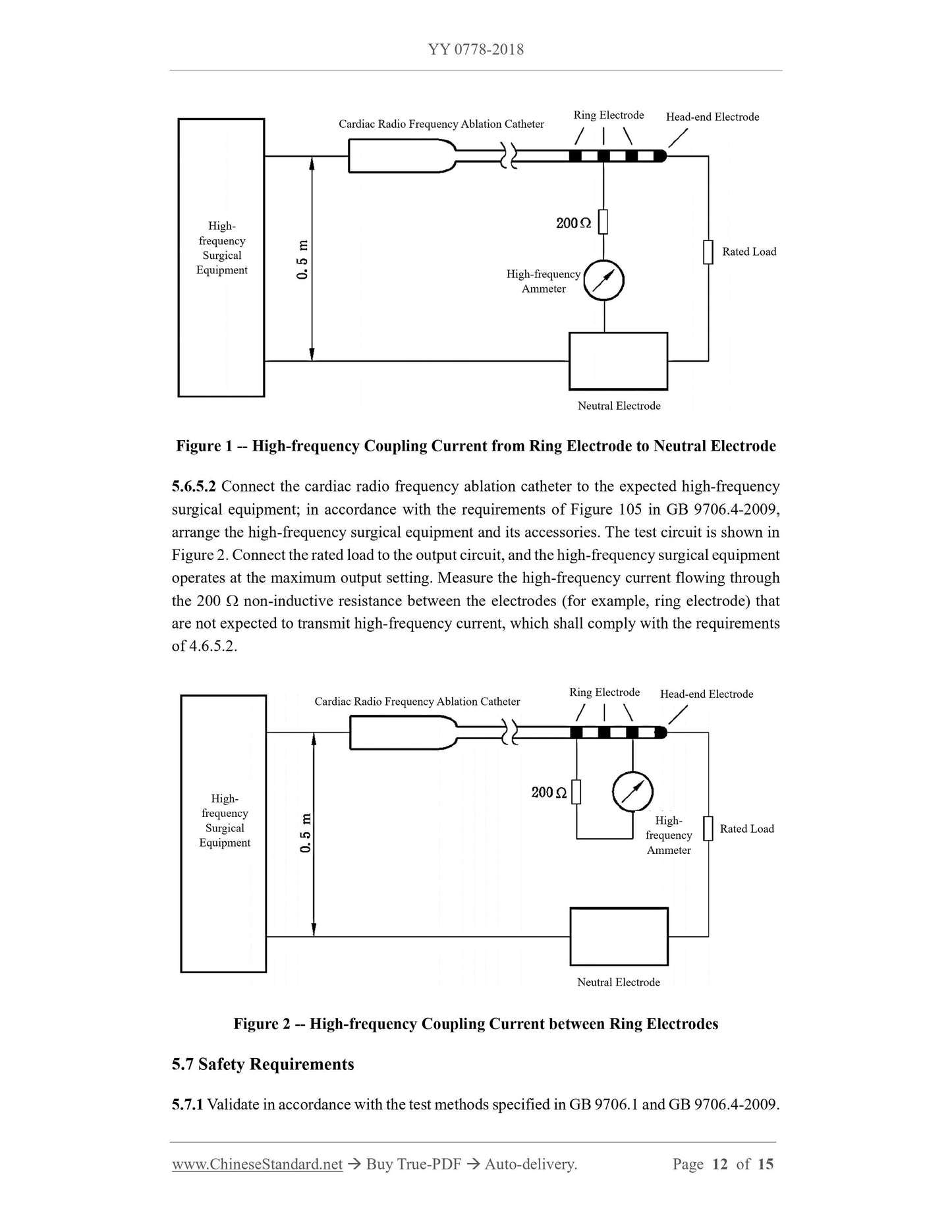1
/
의
12
PayPal, credit cards. Download editable-PDF & invoice in 1 second!
YY 0778-2018 English PDF (YY0778-2018)
YY 0778-2018 English PDF (YY0778-2018)
정가
$160.00 USD
정가
할인가
$160.00 USD
단가
/
단위
배송료는 결제 시 계산됩니다.
픽업 사용 가능 여부를 로드할 수 없습니다.
Delivery: 3 seconds. Download true-PDF + Invoice.
Get QUOTATION in 1-minute: Click YY 0778-2018
Historical versions: YY 0778-2018
Preview True-PDF (Reload/Scroll if blank)
YY 0778-2018: Radio frequency ablation catheter
YY 0778-2018
YY
PHARMACEUTICAL INDUSTRY STANDARD
OF THE PEOPLE’S REPUBLIC OF CHINA
ICS 11.040.60
C 42
Replacing YY 0778-2010
Radio Frequency Ablation Catheter
射频消融导管
ISSUED ON: DECEMBER 20, 2018
IMPLEMENTED ON: JUNE 1, 2020
Issued by: National Medical Products Administration
Table of Contents
Foreword ... 3
1 Scope ... 4
2 Normative References ... 4
3 Terms and Definitions ... 5
4 Requirements ... 5
5 Test Methods ... 8
Appendix A (normative) Test Method for Bending Fatigue ... 14
Radio Frequency Ablation Catheter
1 Scope
This Standard specifies the terms and definitions, requirements and test methods of radio
frequency ablation catheter.
This Standard is applicable to surgical accessories used as high-frequency surgical equipment,
catheters that can transmit radio frequency energy to target tissues through blood vessels and
lumens, and perform cutting and ablation of target tissues, hereinafter referred to as catheters.
2 Normative References
The following documents are indispensable to the application of this document. In terms of
references with a specified date, only versions with a specified date are applicable to this
document. In terms of references without a specified date, the latest version (including all the
modifications) is applicable to this document.
GB/T 1962.2-2001 Conical Fittings with a 6% (Luer) Taper for Syringes, Needles and
Certain Other Medical Equipment - Part 2: Lock Fittings (ISO 594-2:1998, IDT)
GB 9706.1 Medical Electrical Equipment - Part 1: General Requirements for Safety
GB 9706.4-2009 Medical Electrical Equipment - Part 2-2: Particular Requirements for the
Safety of High Frequency Surgical Equipment (IEC 60601-2-2:2006, IDT)
GB 9706.19-2000 Medical Electrical Equipment - Part 2: Particular Requirements for the
Safety of Endoscopic Equipment
GB/T 14233.1-2008 Test Methods for Infusion, Transfusion, Injection Equipment for
Medical Use - Part 1: Chemical Analysis Methods
GB/T 14233.2-2005 Test Methods for Infusion, Transfusion, Injection Equipment for
Medical Use - Part 2: Biological Test Methods
GB/T 16886.1 Biological Evaluation of Medical Devices - Part 1: Evaluation and Testing
within a Risk Management Process
YY 0285.1-2017 Intravascular Catheters - Sterile and Single-use Catheters - Part 1: General
Requirements
be free from processing and surface defects, and cause minimal damage to blood
vessels or lumens during application.
c) If the catheter is lubricated, when examined with normal or corrected vision, the outer
surface of the catheter shall have no visible converged lubricant droplets.
4.2.2 Breaking force
When carrying out the test in accordance with the specified method, the breaking force of each
test section shall comply with the stipulations of Table 1 in YY 0285.1-2017.
4.2.3 Controllability of regulating mechanism
If the catheter has an adjustable mechanism, then, it shall satisfy the controllability requirements
specified by the manufacturer.
4.2.4 Bending fatigue
Put the catheter in the bending model, repeatedly push and pull for 10 times; and rotate 180
then push and pull for 10 times. the appearance of the catheter shall manifest no obvious
degumming, cracking, breaking and other adverse phenomena, and shall comply with the
requirements of 4.2.3 and 4.5.1.
4.2.5 Luer taper
The Luer taper lock fittings on the catheter shall comply with the requirements of GB/T 1962.2-
2001.
4.3 Chemical Properties
4.3.1 Corrosion resistance
After the corrosion test, there shall be no traces of corrosion on the metal parts of the catheter.
4.3.2 Reducing substances
The difference in consumption of potassium permanganate solution [c(KMnO4) = 0.002 mol/L]
between the test solution and the same volume of the same batch of blank control solution shall
not exceed 2.0 mL.
4.3.3 Heavy metal
The color presented by the test solution shall not exceed the standard control solution with a
mass concentration of ρ (Pb2+) = 1 g/mL.
4.3.4 pH
The difference between the test solution pH and the same batch of blank control solution shall
not exceed 1.5.
4.3.5 Evaporation residue
In 50 mL test solution, the total mass of non-volatile matter shall not exceed 2 mg.
4.3.6 Ethylene oxide residue
If ethylene oxide is used for sterilization, the residual amount shall not be greater than 10 g/g.
4.3.7 UV absorbance
The absorbance of the test solution within the wavelength range of 250 nm ~ 320 nm shall not
be greater than 0.1.
4.4 Biological Properties
4.4.1 Sterility
Sterilized catheters shall be subjected to a validated sterilization process to be sterile.
4.4.2 Biocompatibility
The parts expected to come into contact with biological tissues, cells or body fluids shall be
assessed and documented in accordance with the guidelines and principles provided in GB/T
16886.1.
4.5 Electrical Properties
4.5.1 DC resistance
The DC resistance value of the wire between each electrode and the corresponding core pin in
the handle jack shall comply with the manufacturer’s regulations.
4.5.2 Insulation resistance of catheter
4.5.2.1 Insulation resistance between electrodes
The insulation resistance between any electrode of the multi-core (pole) catheter and the core
pins of the corresponding tail wire jacks of other electrodes, and between the core pins of the
tail wire jacks corresponding to the temperature sensor shall be greater than 5 M.
4.5.2.2 Insulation resistance between electrode and outer tube
The insulation resistance between the outer tube of the catheter and the core pin of the handle
jack shall be greater than 5 M.
4.5.3 Temperature sensing accuracy
If the catheter has a temperature sensor, then, within the temperature range specified by the
manufacturer, the error between the temperature sensing value of the temperature sensor and
f) Ethylene oxide residue: when inspected in accordance with Chapter 9 in GB/T
14233.1-2008, they shall comply with the requirements of 4.3.6.
g) UV absorbance: when inspected in accordance with Chapter 7 in GB/T 14233.1-2008,
they shall comply with the requirements of 4.3.7.
5.4 Biological Properties
5.4.1 Sterility
In accordance with the method specified in GB/T 14233.2-2005, inspect the products in aseptic
packaging, which shall comply with the requirements of 4.4.1.
5.4.2 Biocompatibility
The biocompatibility test shall be carried out in accordance with the methods and procedures
specified in GB/T 16886.1.
5.5 Electrical Properties
5.5.1 DC resistance
Use a high-precision multimeter to measure the DC resistance between the corresponding
electrode and the handle jack, which shall comply with the requirements of 4.5.1.
5.5.2 Insulation resistance of catheter
5.5.2.1 Insulation resistance between electrodes
Use DC resistance measuring equipment, under the condition of 500 V voltage, measure the
DC insulation resistance between different electrodes, which shall comply with the
requirements of 4.5.2.1.
5.5.2.2 Insulation resistance between electrode and outer tube
Use DC resistance measuring equipment, under the condition of 500 V voltage, measure the
insulation resistance between the catheter sheath and the core pin of the handle jack, which
shall comply with the requirements of 4.5.2.2.
5.5.3 Temperature sensing accuracy
Connect the catheter to the equipment specified by the manufacturer, simultaneously put the
temperature sensor and the standard thermometer...
Get QUOTATION in 1-minute: Click YY 0778-2018
Historical versions: YY 0778-2018
Preview True-PDF (Reload/Scroll if blank)
YY 0778-2018: Radio frequency ablation catheter
YY 0778-2018
YY
PHARMACEUTICAL INDUSTRY STANDARD
OF THE PEOPLE’S REPUBLIC OF CHINA
ICS 11.040.60
C 42
Replacing YY 0778-2010
Radio Frequency Ablation Catheter
射频消融导管
ISSUED ON: DECEMBER 20, 2018
IMPLEMENTED ON: JUNE 1, 2020
Issued by: National Medical Products Administration
Table of Contents
Foreword ... 3
1 Scope ... 4
2 Normative References ... 4
3 Terms and Definitions ... 5
4 Requirements ... 5
5 Test Methods ... 8
Appendix A (normative) Test Method for Bending Fatigue ... 14
Radio Frequency Ablation Catheter
1 Scope
This Standard specifies the terms and definitions, requirements and test methods of radio
frequency ablation catheter.
This Standard is applicable to surgical accessories used as high-frequency surgical equipment,
catheters that can transmit radio frequency energy to target tissues through blood vessels and
lumens, and perform cutting and ablation of target tissues, hereinafter referred to as catheters.
2 Normative References
The following documents are indispensable to the application of this document. In terms of
references with a specified date, only versions with a specified date are applicable to this
document. In terms of references without a specified date, the latest version (including all the
modifications) is applicable to this document.
GB/T 1962.2-2001 Conical Fittings with a 6% (Luer) Taper for Syringes, Needles and
Certain Other Medical Equipment - Part 2: Lock Fittings (ISO 594-2:1998, IDT)
GB 9706.1 Medical Electrical Equipment - Part 1: General Requirements for Safety
GB 9706.4-2009 Medical Electrical Equipment - Part 2-2: Particular Requirements for the
Safety of High Frequency Surgical Equipment (IEC 60601-2-2:2006, IDT)
GB 9706.19-2000 Medical Electrical Equipment - Part 2: Particular Requirements for the
Safety of Endoscopic Equipment
GB/T 14233.1-2008 Test Methods for Infusion, Transfusion, Injection Equipment for
Medical Use - Part 1: Chemical Analysis Methods
GB/T 14233.2-2005 Test Methods for Infusion, Transfusion, Injection Equipment for
Medical Use - Part 2: Biological Test Methods
GB/T 16886.1 Biological Evaluation of Medical Devices - Part 1: Evaluation and Testing
within a Risk Management Process
YY 0285.1-2017 Intravascular Catheters - Sterile and Single-use Catheters - Part 1: General
Requirements
be free from processing and surface defects, and cause minimal damage to blood
vessels or lumens during application.
c) If the catheter is lubricated, when examined with normal or corrected vision, the outer
surface of the catheter shall have no visible converged lubricant droplets.
4.2.2 Breaking force
When carrying out the test in accordance with the specified method, the breaking force of each
test section shall comply with the stipulations of Table 1 in YY 0285.1-2017.
4.2.3 Controllability of regulating mechanism
If the catheter has an adjustable mechanism, then, it shall satisfy the controllability requirements
specified by the manufacturer.
4.2.4 Bending fatigue
Put the catheter in the bending model, repeatedly push and pull for 10 times; and rotate 180
then push and pull for 10 times. the appearance of the catheter shall manifest no obvious
degumming, cracking, breaking and other adverse phenomena, and shall comply with the
requirements of 4.2.3 and 4.5.1.
4.2.5 Luer taper
The Luer taper lock fittings on the catheter shall comply with the requirements of GB/T 1962.2-
2001.
4.3 Chemical Properties
4.3.1 Corrosion resistance
After the corrosion test, there shall be no traces of corrosion on the metal parts of the catheter.
4.3.2 Reducing substances
The difference in consumption of potassium permanganate solution [c(KMnO4) = 0.002 mol/L]
between the test solution and the same volume of the same batch of blank control solution shall
not exceed 2.0 mL.
4.3.3 Heavy metal
The color presented by the test solution shall not exceed the standard control solution with a
mass concentration of ρ (Pb2+) = 1 g/mL.
4.3.4 pH
The difference between the test solution pH and the same batch of blank control solution shall
not exceed 1.5.
4.3.5 Evaporation residue
In 50 mL test solution, the total mass of non-volatile matter shall not exceed 2 mg.
4.3.6 Ethylene oxide residue
If ethylene oxide is used for sterilization, the residual amount shall not be greater than 10 g/g.
4.3.7 UV absorbance
The absorbance of the test solution within the wavelength range of 250 nm ~ 320 nm shall not
be greater than 0.1.
4.4 Biological Properties
4.4.1 Sterility
Sterilized catheters shall be subjected to a validated sterilization process to be sterile.
4.4.2 Biocompatibility
The parts expected to come into contact with biological tissues, cells or body fluids shall be
assessed and documented in accordance with the guidelines and principles provided in GB/T
16886.1.
4.5 Electrical Properties
4.5.1 DC resistance
The DC resistance value of the wire between each electrode and the corresponding core pin in
the handle jack shall comply with the manufacturer’s regulations.
4.5.2 Insulation resistance of catheter
4.5.2.1 Insulation resistance between electrodes
The insulation resistance between any electrode of the multi-core (pole) catheter and the core
pins of the corresponding tail wire jacks of other electrodes, and between the core pins of the
tail wire jacks corresponding to the temperature sensor shall be greater than 5 M.
4.5.2.2 Insulation resistance between electrode and outer tube
The insulation resistance between the outer tube of the catheter and the core pin of the handle
jack shall be greater than 5 M.
4.5.3 Temperature sensing accuracy
If the catheter has a temperature sensor, then, within the temperature range specified by the
manufacturer, the error between the temperature sensing value of the temperature sensor and
f) Ethylene oxide residue: when inspected in accordance with Chapter 9 in GB/T
14233.1-2008, they shall comply with the requirements of 4.3.6.
g) UV absorbance: when inspected in accordance with Chapter 7 in GB/T 14233.1-2008,
they shall comply with the requirements of 4.3.7.
5.4 Biological Properties
5.4.1 Sterility
In accordance with the method specified in GB/T 14233.2-2005, inspect the products in aseptic
packaging, which shall comply with the requirements of 4.4.1.
5.4.2 Biocompatibility
The biocompatibility test shall be carried out in accordance with the methods and procedures
specified in GB/T 16886.1.
5.5 Electrical Properties
5.5.1 DC resistance
Use a high-precision multimeter to measure the DC resistance between the corresponding
electrode and the handle jack, which shall comply with the requirements of 4.5.1.
5.5.2 Insulation resistance of catheter
5.5.2.1 Insulation resistance between electrodes
Use DC resistance measuring equipment, under the condition of 500 V voltage, measure the
DC insulation resistance between different electrodes, which shall comply with the
requirements of 4.5.2.1.
5.5.2.2 Insulation resistance between electrode and outer tube
Use DC resistance measuring equipment, under the condition of 500 V voltage, measure the
insulation resistance between the catheter sheath and the core pin of the handle jack, which
shall comply with the requirements of 4.5.2.2.
5.5.3 Temperature sensing accuracy
Connect the catheter to the equipment specified by the manufacturer, simultaneously put the
temperature sensor and the standard thermometer...
Share
